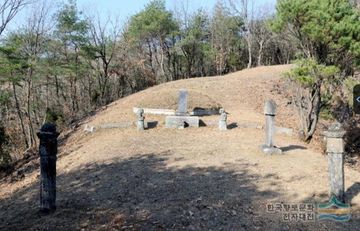이국주 선생 묘
| 이국주 선생 묘 Tomb of Yi Guk-ju |
|
| 대표명칭 | 이국주 선생 묘 |
|---|---|
| 영문명칭 | Tomb of Yi Guk-ju |
| 한자 | 李國柱 先生 墓 |
| 주소 | 경기도 포천시 화현면 지현리 산5-8 |
| 지정(등록) 종목 | 포천시 향토유적 제37호 |
| 지정(등록)일 | 1986년 4월 9일 |
| 소유자 | 사유 |
|
|
|
해설문
국문
조선 전기의 문신 이국주(李國柱, 1487~1556)와 부인 여주민씨·비안박씨의 합장묘다.
이국주는 중종 20년(1525) 사마시에 합격하여 진사가 되어서 성균관에 입학하였다. 여러 번 문과 시험에 실패하였으나 성품이 효성스럽고 의로웠다. 당시 권력자가 이러한 그를 높이 평가하여 의장고 낭청에 천거하였으며 이 자리에서 오랫동안 재직하였다. 70세에 이천현감으로 재직 중 별세하였다. 늦게 낳은 아들 이호민(李好閔, 1553~1634)이 현달하여 선조(1567~1608 재위) 때 연릉부원군(延陵府院君)에 책봉되었다.
묘역에는 호석을 두른 원형 봉분과 묘갈·상석·향로석·동자석·망주석이 있다. 묘갈은 후대에 세운 것으로, 이경의(李景義, 1590~1640)가 글을 지었다. 조금 떨어진 좌측에는 선조 즉위년(1567)에 세워진 원래의 묘비가 있다. 머릿돌 앞면에 구름 속의 태양과 발이 셋인 까마귀 삼족오를 조각하고, 뒷면에 구름 속의 달을 표현하였다. 비문은 정사룡(鄭士龍, 1494~1573)이 짓고, 송인(宋寅, 1517~1584)이 해서체로 썼다.
영문
Tomb of Yi Guk-ju
This is the tomb of Yi Guk-ju (1487-1556), a civil official of the Joseon period (1392-1910), and his first and second wives, Lady Min and Lady Bak.
Yi Guk-ju passed the preliminary state examination in 1525, but failed to pass the state examination despite several attempts. However, his filial piety and righteous personality caught the attention of those in power, and he was appointed as an administrator at a storehouse of accessories worn during state rituals, where he worked for many years. He died of disease while serving as local magistrate of Icheon.
The round tomb mound is surrounded by rectangular stones at the base. In front of the mound is a tombstone, a stone table, a stone incense table, two child statues, a tombstone with a capstone, and two stone pillars. The tombstone with the capstone was erected in 1567. The epitaph was composed by the civil official Jeong Sa-ryong (1494-1573) and calligraphed in semi-cursive Chinese script by the scholar Song In (1517-1584). The capstone is decorated on the front with engravings of a three-legged crow in front of the sun peeking through clouds and, on the back, the moon peeking through clouds. The tombstone directly in front of the tomb mound was erected later, and its epitaph was composed by the civil official Yi Gyeong-ui (1590-1640).
